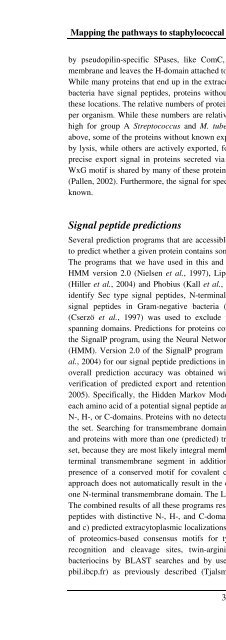The Staphylococcus aureus secretome - TI Pharma
The Staphylococcus aureus secretome - TI Pharma
The Staphylococcus aureus secretome - TI Pharma
You also want an ePaper? Increase the reach of your titles
YUMPU automatically turns print PDFs into web optimized ePapers that Google loves.
Mapping the pathways to staphylococcal pathogenesis by comparative secretomics<br />
by pseudopilin-specific SPases, like ComC, takes place at the cytoplasmic side of the<br />
membrane and leaves the H-domain attached to the translocated protein.<br />
While many proteins that end up in the extracellular milieu or the cell wall of Gram-positive<br />
bacteria have signal peptides, proteins without known export signals can also be found on<br />
these locations. <strong>The</strong> relative numbers of proteins without known signal peptides seem to vary<br />
per organism. While these numbers are relatively low for B. subtilis and S. <strong>aureus</strong>, they are<br />
high for group A Streptococcus and M. tuberculosis (Tjalsma et al., 2004). As indicated<br />
above, some of the proteins without known export signals appear to be liberated from the cell<br />
by lysis, while others are actively exported, for example via the Ess pathway. Although the<br />
precise export signal in proteins secreted via the Ess pathway has not yet been defined, a<br />
WxG motif is shared by many of these proteins and may serve a function in protein targeting<br />
(Pallen, 2002). Furthermore, the signal for specific release of lysins via holins is presently not<br />
known.<br />
Signal peptide predictions<br />
Several prediction programs that are accessible through the world-wide web are useful tools<br />
to predict whether a given protein contains some sort of sorting signal or SPase cleavage site.<br />
<strong>The</strong> programs that we have used in this and other studies were: SignalP-NN and SignalP-<br />
HMM version 2.0 (Nielsen et al., 1997), LipoP version 1.0 (Juncker et al., 2003), PrediSi<br />
(Hiller et al., 2004) and Phobius (Kall et al., 2004). <strong>The</strong>se programs have been designed to<br />
identify Sec type signal peptides, N-terminal membrane anchors (Phobius), or lipoprotein<br />
signal peptides in Gram-negative bacteria (LipoP). <strong>The</strong> TMHMM-program version 2.0<br />
(Cserzö et al., 1997) was used to exclude proteins with (predicted) multiple membrane<br />
spanning domains. Predictions for proteins containing a signal peptide were performed with<br />
the SignalP program, using the Neural Network (NN) and Hidden Markov Model algorithms<br />
(HMM). Version 2.0 of the SignalP program was preferred above Version 3.0 (Bendtsen et<br />
al., 2004) for our signal peptide predictions in S. <strong>aureus</strong> and S. epidermidis, because the best<br />
overall prediction accuracy was obtained with Version 2.0 in a recent proteomics-based<br />
verification of predicted export and retention signals in B. subtilis (Tjalsma and van Dijl,<br />
2005). Specifically, the Hidden Markov Model in SignalP 2.0 assigns probability scores to<br />
each amino acid of a potential signal peptide and indicates whether it is likely to belong to the<br />
N-, H-, or C-domains. Proteins with no detectable N-, H-, and C-domain were excluded from<br />
the set. Searching for transmembrane domains was performed with the TMHMM program<br />
and proteins with more than one (predicted) transmembrane domain were excluded from the<br />
set, because they are most likely integral membrane proteins. All proteins with a predicted Cterminal<br />
transmembrane segment in addition to a signal peptide were screened for the<br />
presence of a conserved motif for covalent cell wall binding. It should be noted that this<br />
approach does not automatically result in the exclusion of potential membrane proteins with<br />
one N-terminal transmembrane domain. <strong>The</strong> LipoP-program was used to predict lipoproteins.<br />
<strong>The</strong> combined results of all these programs resulted in a list of proteins, which have: a) signal<br />
peptides with distinctive N-, H-, and C-domains, b) no additional transmembrane domains,<br />
and c) predicted extracytoplasmic localizations. <strong>The</strong>se proteins were scanned for the presence<br />
of proteomics-based consensus motifs for type I, type II or pseudopilin-specific SPase<br />
recognition and cleavage sites, twin-arginine motifs, and known leader peptides of<br />
bacteriocins by BLAST searches and by use of the PAT<strong>TI</strong>NPROT program (http://npsapbil.ibcp.fr)<br />
as previously described (Tjalsma and van Dijl, 2005). To define the core<br />
37













